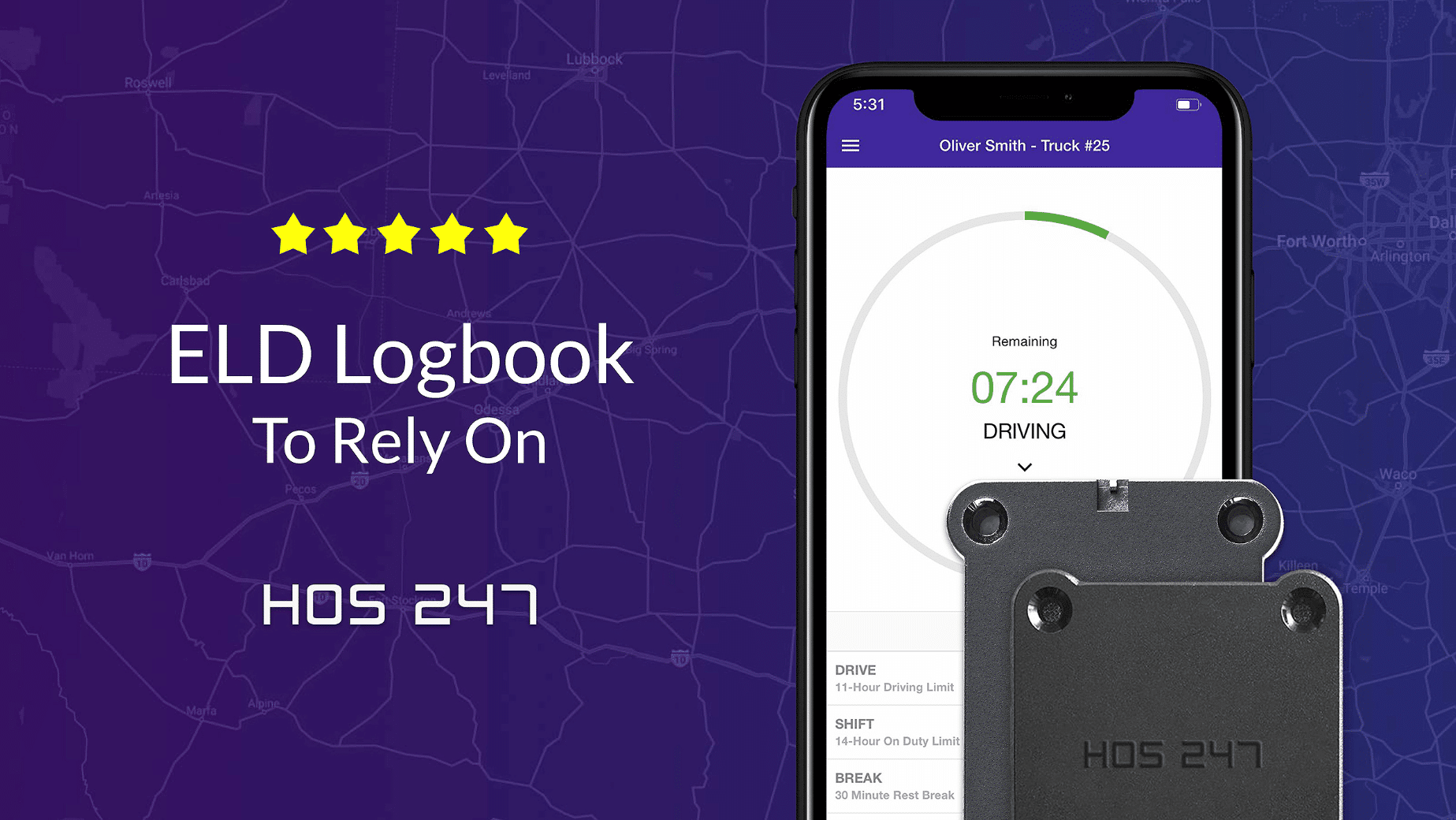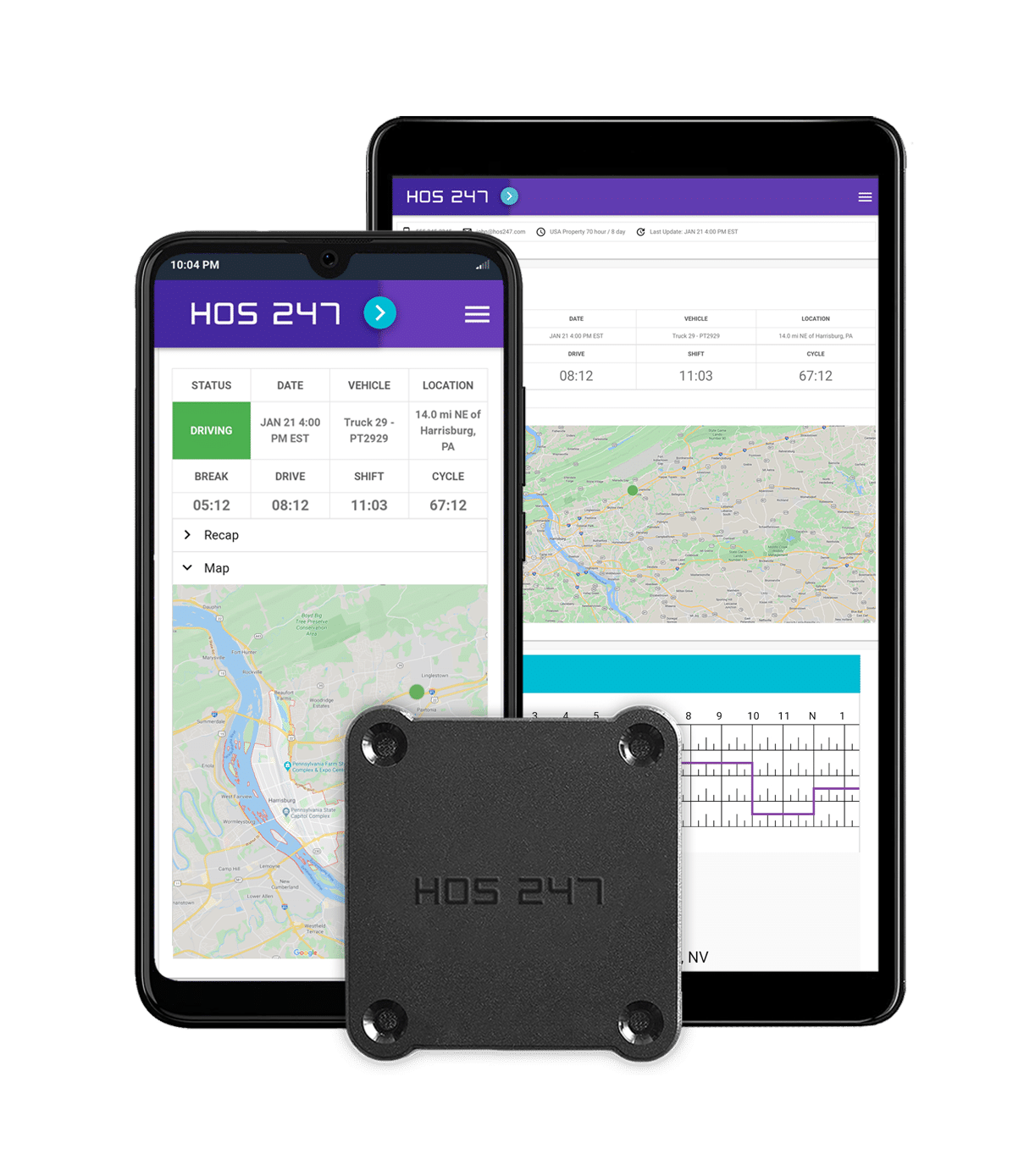Understanding Commercial Hours of Service Regulations in Canada: A Trucker’s Guide to ELD Compliance
- Fernanda
- —
Commercial hours of service (HOS) regulations control how long you can drive, when you must take breaks, and how much rest time you need between shifts. These federal rules aren’t just bureaucratic red tape — they’re designed to prevent driver fatigue, which is a major cause of commercial vehicle accidents in Canada.
Since the Canadian ELD mandate took effect in 2021 (with full enforcement in 2023), staying compliant depends heavily on the quality of your electronic logging device. A reliable electronic logbook helps you track hours accurately and avoid violations. A poor-quality device can lead to data loss, compliance problems, and potential threats to your commercial driver’s licence.
This guide covers the essential HOS rules for both freight and passenger operations, common violations to avoid, and why elog quality matters for compliance and operational success. Whether you’re buying your first ELD or switching providers, you’ll learn how to choose a device that supports rather than complicates your compliance efforts.
Do you have any questions? Talk to ELD Advisor: 650-405-3372 or Request Callback
What Are Commercial Hours of Service Regulations?
Commercial hours of service regulations are federal rules established by Transport Canada under the Commercial Vehicle Drivers Hours of Service Regulations. These rules limit how long commercial drivers can operate before taking mandatory rest periods. Like their US counterpart, the goal is to reduce fatigue-related crashes that lead to serious injuries or fatalities.

Who Must Comply with HOS Regulations
Understanding whether HOS regulations apply to your operation is the first step toward compliance. In Canada, HOS rules apply to drivers of commercial motor vehicles (CMVs) who operate in extra-provincial (interjurisdictional) trade — meaning they travel between provinces or across the Canada-US border. These drivers must follow federal HOS rules and use Transport Canada-certified ELDs.
A commercial vehicle is generally defined as one that:
- Has a gross vehicle weight (GVW) or registered gross weight over 4,500 kg.
- Is used to transport passengers or goods.
- Operates between provinces or internationally.
Note: Each province and territory may apply similar or modified HOS rules to intra-provincial operations (within a single province), and may or may not require ELD use for those operations.
Interprovincial vs. Intraprovincial Distinctions
Different HOS rules may apply depending on where and how your fleet operates:
- Interprovincial (federally regulated) commerce involves operations that cross provincial or international borders. These drivers must follow federal HOS regulations and use certified ELDs.
- Intraprovincial (provincially regulated) commerce involves transportation within a single province. Provinces may allow continued use of paper logs or apply modified ELD rules — for example, Alberta, Quebec, and B.C. have their own exemptions for certain fleets.
Always check with your provincial transportation authority for intra-provincial ELD requirements, as not all provinces mandate ELDs for local operations.
Special Situations and Exemptions
Transport Canada and the provinces recognize specific cases where flexibility is needed, which is why some truckers may be exempt, including:
- Short-haul exemption. Drivers who operate within a 160 km radius and return to their home terminal daily may be exempt from using an ELD (paper logs may still be required).
- Emergency exemptions. Temporary exemptions can apply during declared emergencies (e.g., natural disasters, supply chain crises).
- Agricultural operations. Seasonal exemptions may apply during planting or harvest.
- Rental vehicles. CMVs under 30-day rental agreements are temporarily exempt from the ELD requirement.
- Older vehicles. CMVs with model years before 2000 are exempt due to compatibility issues.
- Statutory exemptions. Drivers operating under a specific exemption issued by a provincial or federal authority.
Historical Context and Safety Purpose
Canada’s HOS rules evolved over decades of research and consultation, mirroring international concern over fatigue-related collisions. Industry studies and crash data consistently show that fatigued drivers have slower reaction times, impaired judgment, and higher crash risk.
Before uniform HOS rules, some drivers worked dangerously long hours under pressure to meet deadlines. Federal regulation created a level playing field, ensuring that no carrier cuts corners at the cost of driver safety.
HOS regulations in Canada protect drivers and the public by:
- Limiting consecutive driving hours (e.g., 13 hours max driving in a 14-hour work window).
- Requiring 8 consecutive hours off-duty each day.
- Mandating breaks after extended driving periods.
- Capping total on-duty time per cycle (e.g., 70 hours in 7 days or 120 in 14).
- Allowing cycle resets after required off-duty time.
Understanding these regulations is fundamental, but compliance depends on accurate tracking and documentation. This is where your ELD’s reliability becomes crucial — not only for avoiding penalties, but also for protecting your safety, your licence, and your livelihood.

HOS Rules South vs. North of 60°N
Canada’s federal Hours of Service (HOS) rules change depending on where you’re driving. Most truckers operate under the standard rules south of the 60th parallel, but those running north of 60°N — in remote territories and parts of northern provinces — are subject to more flexible limits due to longer routes, harsh weather, and limited infrastructure.
South of 60°N: Standard HOS Rules
Applies to most federally regulated drivers in Canada, including long-haul routes and interprovincial operations.
- 13-hour driving limit. You can drive up to 13 hours in a day after taking 8 consecutive hours off duty.
- 14-hour on-duty limit. Total on-duty time (driving and non-driving tasks) cannot exceed 14 hours per day.
- 10 hours off-duty daily. You must take at least 10 hours off duty, including a minimum of 8 consecutive hours. The remaining 2 hours can be split into blocks of at least 30 minutes.
- Cycle options:
- Cycle 1. Max 70 hours on duty in 7 days (reset with 36 consecutive hours off).
- Cycle 2. Max 120 hours on duty in 14 days (reset with 72 consecutive hours off).
- Sleeper berth splits. Allowed under strict conditions for splitting the 10-hour rest period (e.g., 8+2 or 7+3 combinations).
North of 60°N: Flexible HOS Rules
Applies in Yukon, Northwest Territories, Nunavut, and northern regions of provinces above the 60th parallel.
- 15-hour driving limit. Drivers may drive up to 15 hours in a day.
- 18-hour on-duty limit. Total on-duty time can extend up to 18 hours per day.
- 20-hour work shift window. The maximum elapsed time from coming on duty to ending a shift is 20 hours.
- 8 consecutive hours off-duty. Before starting a new shift, drivers must take at least 8 consecutive hours off duty (the 10-hour rule does not apply north of 60).
- Cycle options (different thresholds):
- Cycle 1. Max 80 hours on duty in 7 days (reset with 36 consecutive hours off).
- Cycle 2. Max 120 hours on duty in 14 days (reset with 72 consecutive hours off).
- Sleeper berth splits. Single drivers may split off-duty time into 2+6 hour segments. Team drivers have additional flexibility.
Understanding which rules apply to your route is essential for maintaining compliance and configuring your ELD properly. Your electronic logbook must recognize the geographic zone and apply the appropriate rules automatically.
Common HOS Violations and How to Avoid Them
Understanding frequent HOS violations helps you recognize potential problems before they result in fines or out-of-service orders. Most violations are preventable with proper planning and reliable ELD equipment. Most frequent HOS violations include:
Driving Beyond 13-Hour Limit
This violation occurs when drivers exceed the 13-hour maximum daily driving limit. It’s often caused by poor trip planning, delays at shippers or receivers, or incorrect ELD settings.
Prevention Strategies:
- Plan routes with buffer time for unforeseen delays.
- Monitor available driving hours throughout the day.
- Use an ELD that displays real-time calculations of remaining drive time.
- Set alerts when nearing the 13-hour limit.
Exceeding the 14-Hour On-Duty Limit
Drivers sometimes underestimate time spent on non-driving tasks like inspections or waiting at docks, causing them to exceed the 14-hour daily on-duty maximum.
Prevention Strategies:
- Include expected loading/unloading time in your daily schedule.
- Communicate any delays to dispatch as soon as they occur.
- Remember: once you go on duty, the 14-hour window doesn’t pause.
- Consider shorter drive days when extended loading is likely.
Off-Duty Time Not Taken Correctly
Canada requires at least 10 hours off-duty per day, including a minimum of 8 consecutive hours. Drivers who fail to meet these requirements risk violations during audits and inspections.
Prevention Strategies:
- Schedule and stick to 8 consecutive hours off each day.
- Use proper sleeper berth or off-duty designations in your ELD.
- Avoid logging short breaks as on-duty — they won’t count toward required rest time.
- Ensure your ELD logs split rest periods accurately if using them.
Cycle Limit Violations (Cycle 1 and Cycle 2)
Going over the 70-hour limit in 7 days (Cycle 1) or 120-hour limit in 14 days (Cycle 2) can trigger serious penalties or result in being placed out of service.
Prevention Strategies:
- Regularly check weekly hour totals in your ELD.
- Schedule 36- or 72-hour resets in advance to stay within limits.
- Use cycle management reports to monitor trends over time.
Log Form and Manner Errors
Missing fields, incorrect duty status entries, or failure to carry previous 14 days of logs are among the most common violations during inspections.
Prevention Strategies:
- Make sure logs include your full name, date, carrier, vehicle, location, duty status, and odometer.
- Certify daily logs promptly.
- Keep 14 days of logs accessible, either electronically or in paper backup.
- Never falsify or backfill duty status changes.
Ignoring an Out-of-Service Order
Continuing to drive after being placed out of service is a major violation that can result in license suspensions and fleet-level penalties.
Prevention Strategies:
- Immediately stop operating if given an OOS order.
- Do not resume driving until the required off-duty period is complete and the violation is cleared.
ELD Malfunctions Leading to Compliance Issues
While driver error causes many HOS violations, equipment failures can also put you at risk of compliance problems. These are some common elog problems drivers should recognize before they become serious compliance risks:
- Data synchronization problems. When your ELD fails to properly sync between hardware and mobile app, you may lose driving time data or have incomplete logs.
- Connectivity failures. Poor cellular coverage or device connectivity issues can result in gaps in electronic logs.
- Incorrect hour calculations. Some electronic logbooks miscalculate available hours, especially with complex scheduling scenarios.
- Hardware reliability issues. Frequent device failures or hardware malfunctions can compromise your ability to maintain compliant logs.
The quality and reliability of your ELD directly impacts your ability to avoid these violations. A well-designed, thoroughly tested device with responsive customer support can prevent costly compliance problems.

Electronic Logging Compliance Checklist
Understanding the mandate’s requirements and inspection procedures helps you stay compliant and avoid problems during roadside checks.
Your ELD Must:
- Be certified by an accredited body under the CCMTA Technical Standard and listed on Transport Canada’s approved ELD list.
- Connect to your vehicle’s engine control module (ECM) to capture required data elements automatically.
- Automatically record driving time when the vehicle moves above 8 km/h (approximately 5 mph).
- Transfer data to enforcement officers during roadside inspections via email, USB, or Bluetooth, covering the current day plus the last 14 days.
- Be tamper-resistant and secure from unauthorized modifications as defined by the CCMTA standard.
Driver Responsibilities:
- Verify your ELD records are accurate and up to date.
- Add notes for any duty status changes not recorded automatically (e.g. personal conveyance).
- Certify your daily logs at the end of each shift.
- Keep supporting documentation (e.g. fuel, delivery, inspection records) for 14 days and have it available during inspections.
- Transfer your records of duty status (RODS) covering the current day plus the previous 14 days to authorized safety officials upon request.
- Report any ELD malfunctions to your motor carrier as soon as the vehicle is parked, and use paper logs for up to 14 days during the malfunction.
Motor Carrier Requirements:
- Provide drivers with an ELD information packet, including the user manual, data transfer instructions, malfunction reporting procedures, and at least 15 days of blank paper logs.
- Keep ELD records and backup data for 6 months on separate devices or systems.
- Ensure no one tampers with or alters original HOS data — all edits must be timestamped and annotated, with originals preserved.
- Repair or replace malfunctioning ELDs within 14 days of notification or before the driver returns to the home terminal, whichever comes first.
- Maintain a register of malfunctions, including details such as driver, vehicle, malfunction code, location, repair date, and actions taken, and retain these records for 6 months.
Following these requirements ensures compliance with Transport Canada’s ELD mandate and helps protect your operation from costly violations, delays, and enforcement actions.

Why ELD Quality Matters for HOS Compliance
The connection between ELD quality and staying compliant goes beyond basic functions. Your electronic logging device is your main record for following federal hours-of-service (HOS) rules under Transport Canada’s mandate, making its reliability and accuracy critical for protecting your commercial driver’s licence (CDL) and career. The switch to electronic logs made ELD reliability more important than ever. Your device isn’t just a tool — it’s your primary protection against HOS violations. Poor-quality ELDs create compliance risks through incorrect hour calculations, lost data, connection problems, and hardware failures that force you back to paper logs.
How Device Reliability Affects Compliance
A quality ELD automatically captures driving time, location data, and vehicle movement accurately. Incorrect or incomplete information can create compliance gaps that enforcement officers treat as violations — even when you followed HOS rules correctly. Your logbook must also calculate available driving time, duty periods, daily rest requirements, and proper off-duty splits based on Transport Canada’s regulations.
Staying compliant depends on being able to produce accurate logs during inspections. Certified, well-built devices retain complete, correct data that enforcement officers can easily access and verify. Quality ELDs also provide timely alerts when you approach your HOS limits, helping you plan stops, rest periods, and routes to avoid unintentional violations.
Real Consequences of Compliance Problems
HOS violations under Canada’s Commercial Vehicle Drivers Hours of Service Regulations carry financial penalties and enforcement actions that can sideline your operations. Serious or repeated violations may result in immediate out-of-service orders until compliance is restored. This can lead to missed deliveries, lost income, and damaged customer relationships.
Violations also impact your carrier profile and provincial safety scores, which influence insurance premiums, licensing status, and future employment opportunities. Persistent HOS violations may put your CDL at risk under provincial sanctions or company policy.
What to Look for in Quality ELDs
When choosing an ELD, focus on key features that directly impact your compliance success and daily operations.
- Hardware reliability includes steady power that prevents unexpected shutdowns, tough construction that handles truck vibrations and temperature changes, and secure mounting that keeps connections stable.
- Software performance means accurate HOS rule implementation that reflects current regulations, easy-to-use interfaces that prevent mistakes, and regular updates that address regulation changes and fix problems.
- Connection stability involves reliable cellular connections across different coverage areas, effective data storage when connections drop, and quick reconnection when coverage returns.
- Customer support quality means knowledgeable technical support available when you need help, quick response times when compliance issues come up, and complete training resources.
The quality of your ELD directly affects your ability to stay compliant in today’s digital environment. Investing in reliable equipment with proven performance protects both your current operations and your long-term career in trucking.
HOS247 ELD: Reliable Solution for Hours of Service Compliance
HOS247 ELD is built for drivers who need dependable compliance tools that work when it matters most. Our system combines reliable hardware, easy-to-use software, and responsive customer support to keep you compliant without the headaches that come with poor-quality devices. Key benefits include:
- Proven reliability. The device consistently performs in real-world conditions, giving you accurate data you can trust during inspections and daily operations.
- User-friendly interface. The intuitive design reduces mistakes and makes logging simple. You spend less time figuring out your electronic logbook and more time driving safely and efficiently.
- Stable connectivity. HOS247 maintains reliable connections even in areas with poor cell coverage. The system stores data when connectivity drops and syncs everything when connection returns, preventing gaps in your logs.
- No long-term contracts. Month-to-month plans mean you stay with HOS247 because it works, not because you’re locked in. This flexibility shows our confidence in the product quality.
- Multilingual support. Available in English, Spanish, Russian, and Polish with customer support every day of the week. Our callback policy ensures if a call drops, we call you back immediately.
- Automatic updates. Software automatically updates to stay current with regulations. You never have to worry about outdated software causing compliance problems.
Additional Features That Matter
- Two-week risk-free trial. Test the system before you commit. This trial period lets you verify that HOS247 meets your needs without risk.
- IFTA calculations. Automatic mileage tracking by jurisdiction reduces paperwork and ensures accurate fuel tax reporting.
- Real-time GPS tracking. Know where your vehicles are and maintain detailed location records for compliance and operational purposes.
- One-year hardware warranty. We stand behind our equipment quality with comprehensive warranty protection.
How HOS247 Solves Common ELD Problems
Many drivers face issues with ELDs that lose data, calculate hours wrong, or offer poor customer support when problems happen. HOS247 fixes these problems directly.
Our system prevents data loss through reliable connectivity technology. Hour calculations stay accurate in all situations, including sleeper berth splits and crossing state lines. When you need help, you talk to knowledgeable support staff who understand trucking, not automated systems that waste your time.
HOS247 works consistently even in remote areas where other devices fail. The system keeps your compliance records safe during connection problems and updates everything quickly when coverage returns.

Conclusion
Staying compliant with commercial hours of service regulations requires more than knowing the rules — you need reliable tools that work consistently. The quality of your ELD directly affects your ability to maintain compliance and protect your career.
Quality ELDs prevent compliance problems before they start. Accurate hour tracking, reliable data storage, stable connections, and responsive support help you avoid violations that can cost hundreds or thousands of dollars. Poor-quality devices create unnecessary risks through data loss, connectivity failures, and inadequate customer support.
When choosing an ELD, focus on proven reliability, ease of use, stable connectivity, and quality customer support. Don’t risk your livelihood with unreliable equipment. Try HOS247 and experience the difference that quality makes in your daily operations.












The trucking industry is undergoing a digital transformation, and at the heart of it is commercial driver log book software. This powerful tool has replaced the traditional paper logbook with a streamlined, automated solution that makes it easier for drivers

In the trucking industry, keeping accurate and up-to-date records is more than just a good practice—it’s a legal requirement. For years, drivers have faced the challenge of maintaining precise logs of their hours, routes, and vehicle conditions, often using traditional

The industry leader of HOS ELD Solutions – HOS247 HOS247 is an industry leader providing HOS ELD Solutions. It provides a complete system including a HOS log book app/portal and a standalone logging device, to make sure all the compliance